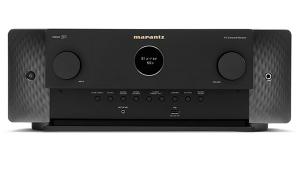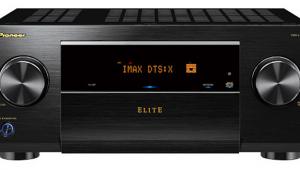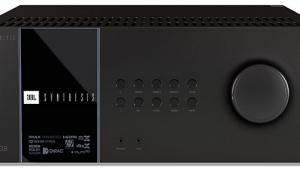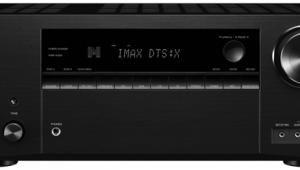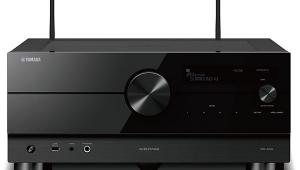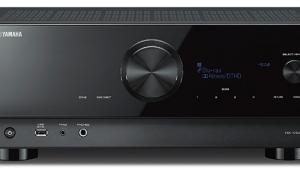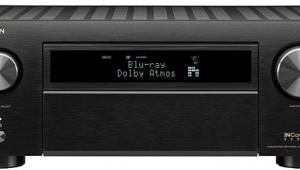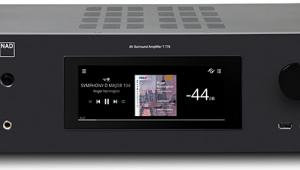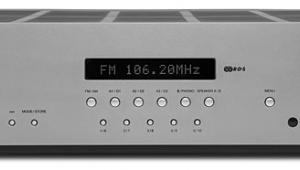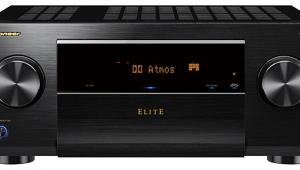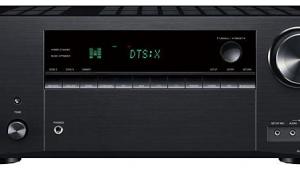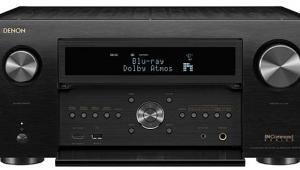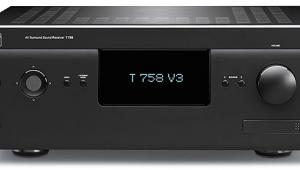Denon DRA-800H Stereo Network Receiver Review
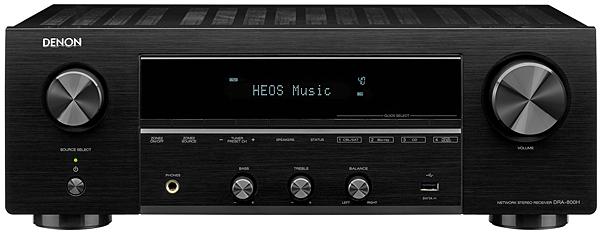
AT A GLANCE
Plus
Audiophile-quality sonics
Easy access to networked and internet-streamed music
Extensive HDMI switching
Minus
Non-backlit remote
THE VERDICT
Denon’s modern take on the classic stereo receiver delivers excellent sound quality, video switching for 2-channel home theater, and all the amenities of an app-driven, internet-connected music system.
As I uncrated the Denon DRA-800H stereo receiver and set it on my rack for review, I was struck by a powerful wave of nostalgia. Back in my early days of audiophilia, stereo—no wait, stereo and vinyl—was pretty much the game. Buying a basic receiver was a typical rite of passage for a high school or college student back then, and it was staring at rows of them at the local TV/appliance store—with their shiny brushed chrome faceplates, dials and buttons, and backlit tuning displays—that got me hooked on audio in the first place.
It didn't take more than a few moments of assessing this new Denon model, though, to know that we have come a long way. At $500, Denon's update of the classic stereo receiver still qualifies as the heart of an awesome starter system for dorm or apartment-dwellers—add bookshelf speakers, or even towers, and maybe a subwoofer, and you're ready to rock, literally and figuratively. But Denon's inclusion of network and wireless connectivity has thoroughly modernized the experience of accessing and exploring music, while the thoughtful addition of HDMI inputs guarantees powerful sound for TV and movie viewing. And if you wanna go retro, all the usual analog inputs are there for the asking, just like in the old days. Best of all, Denon has paid attention to the sound quality, too. Let's have a look and listen.
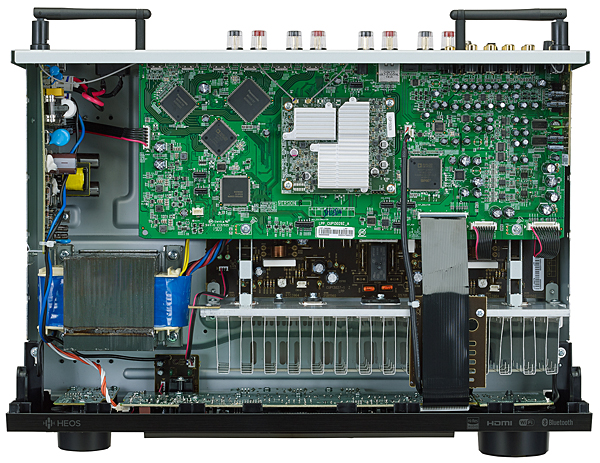
Features
Do a web search and you'll find the DRA-800H joins other stereo receivers from sister brand Marantz, along with Onkyo/Integra, Harman Kardon, Yamaha, Outlaw Audio, and higher-end players such as Arcam and Cambridge Audio. This Denon offers a unique proposition among them, however. There are a couple of pricier and more substantial (that is, heavier) models in its power class with similar audiophile aspirations—the Outlaw RR2160 ($849, review at soundandvision.com) and Arcam SR250 ($2,500) stand out—but neither offers quite the same mix of modern features and ergonomics.
At around 18 pounds in a full rack-width chassis, the Denon straddles the middle while keeping the audiophile firmly in the crosshairs. Its sophisticated, high-current Class A/B amplifier is rated for 100 watts RMS x 2 into 8 ohms (both channels driven, full 20 to 20kHz bandwidth, 0.08% total harmonic distortion), and it'll handle loads down to 4 ohms. Denon has selected high-grade audiophile capacitors and resistors and uses the fully symmetrical design philosophy found in its better amps. Circuit paths have been kept as short and direct as possible. High-quality analog preamp circuitry is touted, along with a pair of 32-bit, 8-channel AKM AK4458 premium DACs whose extra processing power is said to result in improved dynamic range and lower noise. The unit is Hi-Res Audio certified for up to 192 kHz/24-bit FLAC, WAV, and ALAC files, and DSD at 2.8 or 5.6MHz. (Note that AIFF files are not recognized, which left some of my hi-res library unplayable.) As with some other Denon and Marantz receivers and amps, the DRA-800H has both a Direct listening mode that bypasses the bass, treble, balance and Digital Restorer circuitry available for low-bitrate streams, and a Pure Direct mode that goes a step further by deactivating the front-panel display.
The DRA-800H is offered with the typical black faceplate, though a silver version is also available in Europe. Inputs are cycled via a knob on the left, but four Quick Select buttons can be programmed to directly call up any user-selected input along with memorized bass/treble or other settings. The oversized plastic volume knob spins smoothly enough, though I yearned— perhaps unfairly at this price— for the more tactile experience of a fine audiophile component. Other buttons below the display control AM/FM tuner presets, Zone 2 operation, and A/B speaker selection. A USB port accepts high-res audio files presented by a flash or other drive, and there's a headphone output for private listening.

Around back are good-quality plastic binding posts for two switchable speaker pairs—not a bad use of the amp's low-impedance capabilities. There's also a Zone 2 stereo pre-out for driving an amp in a distant room. Analog audio inputs include moving magnet phono (no separate phono stage required), plus assignable RCA jacks for two additional components, such as a CD player. Three digital audio inputs (two optical, one coaxial) can also be assigned to any of five UHD/HDCP2.3-ready HDMI inputs. These pass all UHD HDR10/HLG signals to the HDMI Monitor out, which is also ARC-capable to allow playback of PCM stereo from a smart TV's onboard streaming platform. Dual subwoofer outs are bass-managed via the menu for a low-pass crossover between 40 Hz and 250 Hz.
Network and wireless capabilities are facilitated by either a wired Ethernet connection or onboard Wi-Fi (supported by a pair of antennas on the rear panel). Despite spotty Wi-Fi reception down in my basement listening studio, the receiver locked on and never stuttered through many hours of use. Navigation of network servers, as well as online music streaming, is provided by the Denon HEOS app, which supports major services including Spotify (via Spotify Connect), Tidal, Pandora, Amazon Music, SiriusXM, Deezer, Napster, SoundCloud, Rhapsody, TuneIn Internet radio, and iHeart Radio. It's been a long time since I last used HEOS, and I was impressed with the app's simple and intuitive operation, as well as its attractive graphic presentation. HEOS lets you to build a queue from supporting services and playlists (including Tidal, though not Spotify or Amazon), and you can designate specific Pandora or TuneIn stations, for example, as HEOS Favorites that can be readily accessed via the app, onscreen display, or Quick Select memories. (Unfortunately, that last capability wasn't available with Tidal or Spotify.)
Besides controlling playback with the app, you can navigate via the DRA-800H's onscreen graphic display on a TV connected to the HDMI output. The display updates with commands issued from the HEOS app but also allows independent access to playlists or music stations via the supplied remote. The attractive onscreen graphics show the title, artist, cover art and elapsed time for the current track, onscreen transport buttons, and—quite thoughtfully—the name of the service you're playing from. Where available, it displays the file type and bitrate—tracks from Pandora showed as "MP3-128 kbps," Amazon Music ones as "AAC-256 kbps," and CD-quality Tidal tracks as "FLAC-44.1 kHz/16-bit."
There's more. For direct streaming from a mobile device, you get AirPlay 2 or Bluetooth (not the higher-resolution AptX version, though), with Bluetooth transmission also supported so listeners can use wireless headphones to connect to the DRA-800H. For multiroom support, the Denon is recognized as an AirPlay2 speaker on your network and can therefore be selected for simultaneous playback with other AirPlay 2 devices when streaming from an iOS phone or tablet. Otherwise, you're reliant on the receiver's Zone 2 capabilities or the HEOS app, which can direct the sources or streamed media to other rooms equipped with a HEOS speaker or compatible playback system.

